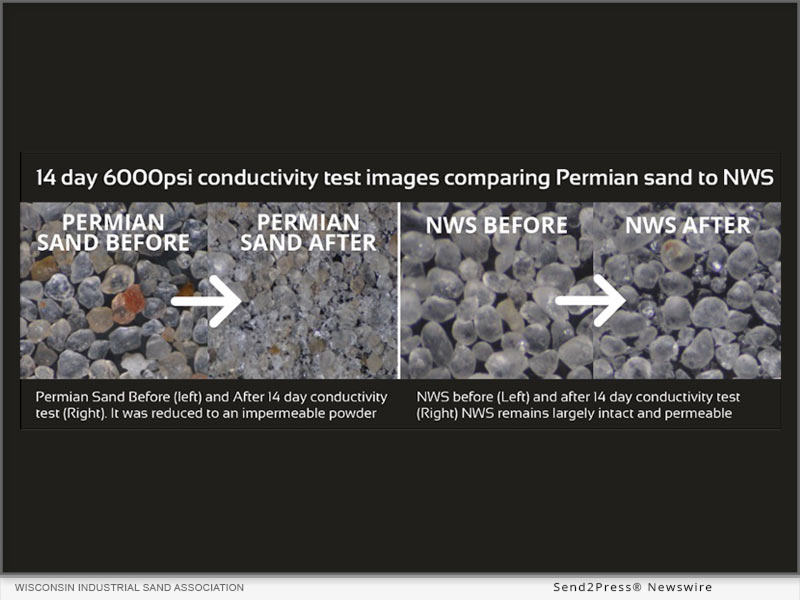EAU CLAIRE, Wis. /ScoopCloud/ -- The Rystad Study, by Rystad Energy, one of North America's most respected energy research firms, focuses on the proppant type used in approximately 900 shale wells in the Permian basin in West Texas. The study compares wells completed using in-basin sand (IBS) with wells completed with northern white sand (NWS), says the Wisconsin Industrial Sand Association (WISA).
Although In-Basin Sand proppants dominate the Permian Market, the study's results indicate that in both the long and short term, most wells would deliver higher productivity using Northern White Sand proppant.
This Rystad Study is the second to examine productivity vs proppant type. It analyses three years of historical data from approximately 900 West Texas Permian Basin shale wells. This latest Rystad Study shows that in 85% of the cases, the short-term cost benefits of completing wells with IBS were lost within the first year when productivity began diverging significantly each year.
Penny Aschenbrenner of Material Spec Labs, which specializes in sand testing, said, "The physical properties of IBS and NWS proppants provide a logical explanation for the difference in production." Material Spec Labs uses API (American Petroleum Institute) testing methods to test frac sand for its customers. "Our job is to test the sand for the physical properties the customer is paying for," said Aschenbrenner. "The idea isn't new. It's sometimes difficult to conceptualize proppant properties and their functionality due to the foreign nature of micro measurements. But if we relate the problem to something we are familiar with, the answer is obvious." she said.
She was not surprised by the negative impact of IBS on wells and questioned whether any technically capable engineer would be either, "The science is pretty simple," she said, "the sand is exposed to extreme pressures and conditions in a well. It is easy to see that the lower-strength sand will crush and clog a well much sooner than a higher-quality proppant. That's what you see in the lab, and it's most likely happening downhole."
NWS became the proppant of choice when the shale revolution began because of its high strength and purity. NWS is a very round, very hard silica sand used to prop open the fractures induced by hydraulic fracturing. Hydraulic fracturing uses water, sand, and chemicals to fracture shale rock deep beneath the earth's surface. When the fracturing is finished, the liquids are returned to the surface, and the sand remains in place to keep the fractures "propped" open, which is why the sand is called a "proppant."
The Rystad study calls the industry's most recent choices into question. By adopting IBS, It's possible that executives did the right thing at the time for their stakeholders. When oil and gas prices plummeted, producers had already spent significant cash on growing production, with many outspending their cash flow by completing more wells than needed. This ultimately led to overproduction and caused prices to crash heading into the pandemic. By the time Covid hit and prices crashed, producers were running out of cash and perhaps considering bankruptcy. Their only option was reducing costs; IBS was an obvious, short-term solution.
So while IBS may have been a company-saving strategy, its use carried an unforeseen expense. As illustrated in the Rystad study findings, those companies, shareholders, mineral rights holders, and U.S. energy security, in general, are now experiencing decreased well productivity and longevity. Despite the early belief that production would stay the same, according to the production data in the Rystad Study, wells completed with IBS now reveal accelerated economic losses in the hundreds of thousands of dollars per well after only a few short years compared to wells completed with NWS. Those losses grow more significant as oil and gas prices increase.
The Rystad Study supports the observation that switching to IBS correlates with accelerating decline rates. It suggests serious consideration of the science and reconsidering of the proppant decision choices. Higher energy prices and demand, the ongoing interest in energy independence, and safety and environmental considerations mandate that oil and gas wells run optimally. Mineral rights holders, energy investors, landowners, and energy workers have significant vested economic interests.
More Information:
The Rystad Study can be found at:
https://drive.google.com/file/d/1DJCbS1a-tWviaoS1pnZQSD8ONoFGdajR/view
Material Spec Labs can be reached at:
https://materialspeclabs.com/
About WISA:
Based in Eau Claire, WI, The Wisconsin Industrial Sand Association is an organization formed to promote safe and environmentally responsible sand mining standards, promote a fact-based discussion, and create a positive dialogue among the industry, citizens, and government officials. https://wisconsinsand.org/
IMAGE FOR MEDIA: https://wisconsinsand.org/wp-content/uploads/sites/77/2023/03/NWS-IBS-BeforeAfter.jpg

The Rystad Study, by Rystad Energy, one of North America's most respected energy research firms, focuses on the proppant type used in approximately 900 shale wells in the Permian basin in West Texas. The study compares wells completed using in-basin sand (IBS) with wells completed with northern white sand (NWS), says the Wisconsin Industrial Sand Association (WISA).
Related link: https://wisconsinsand.org/
This version of news story was published on ScoopCloud™ (ScoopCloud.com) - part of and © the Neotrope® News Network - all rights reserved.
